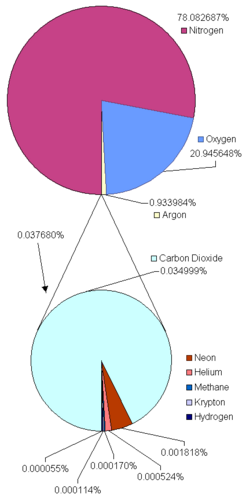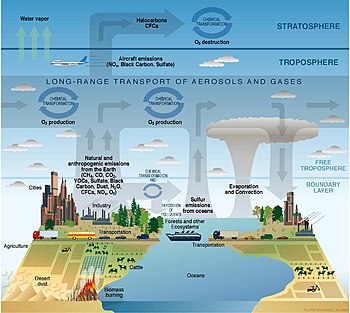| Revision as of 08:36, 9 October 2005 view source222.152.180.157 (talk) →Temperature and the atmospheric layers← Previous edit | Revision as of 09:47, 9 October 2005 view source William M. Connolley (talk | contribs)Autopatrolled, Extended confirmed users, Pending changes reviewers, Rollbackers66,026 editsm dec -> incNext edit → | ||
| Line 9: | Line 9: | ||
| * ]: From the Greek word ''tropos'' meaning to turn or mix. The troposphere is the lowest layer of the atmosphere starting at the surface going up to between 7 km at the poles and 17 km at the equator with some variation due to weather factors. The troposphere has a great deal of vertical mixing due to solar heating at the surface. This heating warms air masses, which then rise to release ] as sensible heat that further buoys the air mass. This process continues until all water vapor is removed. In the troposphere, on average, temperature decreases with height due to ]. | * ]: From the Greek word ''tropos'' meaning to turn or mix. The troposphere is the lowest layer of the atmosphere starting at the surface going up to between 7 km at the poles and 17 km at the equator with some variation due to weather factors. The troposphere has a great deal of vertical mixing due to solar heating at the surface. This heating warms air masses, which then rise to release ] as sensible heat that further buoys the air mass. This process continues until all water vapor is removed. In the troposphere, on average, temperature decreases with height due to ]. | ||
| * ]: from that 7–17 km range to about 50 km, temperature |
* ]: from that 7–17 km range to about 50 km, temperature inccreasing with height. | ||
| * ]: from about 50 km to the range of 80 km to 85 km, temperature decreasing with height. | * ]: from about 50 km to the range of 80 km to 85 km, temperature decreasing with height. | ||
| * ]: from 80–85 km to 640+ km, temperature increasing with height. | * ]: from 80–85 km to 640+ km, temperature increasing with height. | ||
Revision as of 09:47, 9 October 2005

Earth's atmosphere is the layer of gases surrounding the planet Earth and retained by the Earth's gravity. It contains roughly 78% nitrogen and 21% oxygen, with trace amounts of other gases. The atmosphere protects life on Earth by absorbing ultraviolet solar radiation and reducing temperature extremes between day and night.
The atmosphere has no abrupt cut-off. It slowly becomes thinner and fades away into space. There is no definite boundary between the atmosphere and outer space. Three-quarters of the atmosphere's mass is within 11 km of the planetary surface. In the United States, persons who travel above an altitude of 50.0 miles (80.5 km) are designated as astronauts. An altitude of 120 km (75 mi or 400,000 ft) marks the boundary where atmospheric effects become noticeable during re-entry. The Karman line, at 100 km (62 mi), is also frequently used as the boundary between atmosphere and space.
Temperature and the atmospheric layers
The temperature of the Earth's atmosphere varies with altitude; the mathematical relationship between temperature and altitude varies between the different atmospheric layers:
- troposphere: From the Greek word tropos meaning to turn or mix. The troposphere is the lowest layer of the atmosphere starting at the surface going up to between 7 km at the poles and 17 km at the equator with some variation due to weather factors. The troposphere has a great deal of vertical mixing due to solar heating at the surface. This heating warms air masses, which then rise to release latent heat as sensible heat that further buoys the air mass. This process continues until all water vapor is removed. In the troposphere, on average, temperature decreases with height due to expansive cooling.
- stratosphere: from that 7–17 km range to about 50 km, temperature inccreasing with height.
- mesosphere: from about 50 km to the range of 80 km to 85 km, temperature decreasing with height.
- thermosphere: from 80–85 km to 640+ km, temperature increasing with height.
The boundaries between these regions are named the tropopause, stratopause, and mesopause.
The average temperature of the atmosphere at the surface of earth is 14 °C.
Various atmospheric regions
Atmospheric regions are also named in other ways:
- ionosphere — the region containing ions: approximately the mesosphere and thermosphere up to 550 km.
- exosphere — above the ionosphere, where the atmosphere thins out into space.
- magnetosphere — the region where the Earth's magnetic field interacts with the solar wind from the Sun. It extends for tens of thousands of kilometers, with a long tail away from the Sun.
- ozone layer — or ozonosphere, approximately 10 - 50 km, where stratospheric ozone is found. Note that even within this region, ozone is a minor constituent by volume.
- upper atmosphere — the region of the atmosphere above the mesopause.
- Van Allen radiation belts — regions where particles from the Sun become concentrated.
Pressure
- Main article: Atmospheric pressure
Atmospheric pressure is a direct result of the weight of the air. This means that air pressure varies with location and time because the amount (and weight) of air above the earth varies with location and time. Atmospheric pressure drops by ~50% at an altitude of about 5 km (equivalently, about 50% of the total atmospheric mass is within the lowest 5 km). The average atmospheric pressure, at sea level, is about 101.3 kilopascals (about 14.7 pounds per square inch).
Composition

| Percent Composition of Dry Atmosphere, by volume - ppmv: parts per million by volume | ||
|---|---|---|
| Gas | per NASA | |
| Nitrogen (N2) | 78.084% | |
| Oxygen (O2) | 20.946% | |
| Argon (Ar) | 0.9340% | |
| Carbon dioxide (CO2) | 365 ppmv | |
| Neon (Ne) | 18.18 ppmv | |
| Helium (He) | 5.24 ppmv | |
| Methane (CH4) | 1.745 ppmv | |
| Krypton (Kr) | 1.14 ppmv | |
| Hydrogen (H2) | 0.55 ppmv | |
| Not included in above composition of dry atmosphere: | ||
| Water vapor | Highly variable; typically makes up about 1% | |
Carbon dioxide and methane updated (to 1998) by IPCC TAR table 6.1
Minor components of air not listed above include: nitrous oxide (0.5 ppmv), xenon (0.09 ppmv), ozone (0.0 to 0.07 ppmv, 0.0 to 0.02 ppmv in winter), nitrogen dioxide (0.02 ppmv), iodine (0.01 ppmv), carbon monoxide (0.0 to trace), and ammonia (0.0 to trace).
The mean molecular mass of air is 28.97 g/mol.
Heterosphere
Below an altitude of about 100 km, the Earth's atmosphere has a more-or-less uniform composition (apart from water vapor) as described above. However, above about 100 km, the Earth's atmosphere begins to have a composition which varies with altitude. This is essentially because, in the absence of mixing, the density of a gas falls off exponentially with increasing altitude, but at a rate which depends on the molecular mass. Thus higher mass constituents, such as oxygen and nitrogen, fall off more quickly than lighter constituents such as helium, molecular hydrogen, and atomic hydrogen. Thus there is a layer, called the heterosphere, in which the earth's atmosphere has varying composition. As the altitude increases, the atmosphere is dominated successively by helium, molecular hydrogen, and atomic hydrogen. The precise altitude of the heterosphere and the layers it contains varies significantly with temperature.
Density and mass
The density of air at sea level is about 1.2 kg/m. Natural variations of the barometric pressure occur at any one altitude as a consequence of weather. This variation is relatively small for inhabited altitudes but much more pronounced in the outer atmosphere and space due to variable solar radiation
The atmospheric density decreases as the altitude increases. This variation can be approximately modeled using the barometric formula. More sophisticated models are used by meteorologists and space agencies to predict weather and orbital decay of satellites.
The total mass of the atmosphere is about 5.1 × 10 kg, or about 0.9 ppm of the Earth's total mass.
The above composition percentages are done by volume. Assuming that the gases act like ideal gases, we can add the percentages p multiplied by their molar masses m, to get a total t = sum (p·m). Any element's percent by mass is then p·m/t. When we do this to the above percentages, we get that, by mass, the composition of the atmosphere is 75.523% N2, 23.133% O2, 1.288% Ar, 0.053% CO2, 0.001267% Ne, 0.00029% CH4, 0.00033% Kr, 0.000724% He, and 0.0000038 % H2.

This graph is from the NRLMSISE-00 atmosphere model, which has as inputs: latitude, longitude, date, time of day, altitude, solar flux, and the earth's magnetic field daily index.
The evolution of the Earth's atmosphere

The history of the Earth's atmosphere prior to one billion years ago is poorly understood, but the following presents a plausible sequence of events. This remains an active area of research.
The modern atmosphere is sometimes referred to as Earth's "third atmosphere", in order to distinguish the current chemical composition from two notably different previous compositions. The original atmosphere was primarily helium and hydrogen; heat (from the still molten crust, and the sun) dissipated this atmosphere.
About 3.5 billion years ago, the surface had cooled enough to form a crust, still heavily populated with volcanoes which released steam, carbon dioxide, and ammonia. This led to the "second atmosphere"; which was, primarily, carbon dioxide and water vapor, with some nitrogen but virtually no oxygen. (Though very recent simulations run at the University of Waterloo and University of Colorado in 2005 suggested that it may have had up to 40% hydrogen.) This second atmosphere had ~100 times as much gas as the current atmosphere. It is generally believed that the greenhouse effect, caused by high levels of carbon dioxide, kept the Earth from freezing.
During the next few billion years, water vapor condensed to form rain and oceans, which began to dissolve carbon dioxide. Approximately 50% of the carbon dioxide would be absorbed into the oceans. One of the earliest types of bacteria are the cyanobacteria. Fossil evidence indicates that these bacteria existed approximately 3.3 billion years ago and were the first oxygen producing evolving phototropic organisms. They are responsible for the initial conversion of the earth’s atmosphere from an anoxic (state without oxygen) to an oxic (with oxygen) state. Being the first to carry out oxygenic photosynthesis, they were able to convert carbon dioxide into oxygen playing a major role in oxygenating the atmosphere.
Photosynthesizing plants would evolve and convert more carbon dioxide into oxygen. Over time, excess carbon became locked in fossil fuels, sedimentary rocks (notably limestone), and animal shells. As oxygen was released, it reacted with ammonia to create nitrogen; in addition, bacteria would also convert ammonia into nitrogen.
As more plants appeared, the levels of oxygen increased significantly (while carbon dioxide levels dropped). At first it combined with various elements (such as iron), but eventually oxygen accumulated in the atmosphere — resulting in mass extinctions and further evolution. With the appearance of an ozone layer (ozone is an allotrope of oxygen) lifeforms were better protected from ultraviolet radiation. This oxygen-nitrogen atmosphere is the "third atmosphere".
References
- The thermosphere: a part of the heterosphere, by J. Vercheval (viewed 1 Apr 2005)
See also
- Air
- Air glow
- Atmospheric electricity
- Global warming
- Greenhouse effect
- Historical temperature record
- Intergovernmental Panel on Climate Change (IPCC)